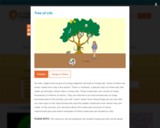
Learn how basic elements form molecules to support life.
A free CK-12 account is required to view all materials.
- Subject:
- Mathematics
- Science
- Material Type:
- Lesson
- Provider:
- CK-12 Foundation
- Provider Set:
- CK-12 Life Science
- Date Added:
- 10/02/2022

Learn how basic elements form molecules to support life.
A free CK-12 account is required to view all materials.

This simulation provides the opportunity to practice performing a ligation
reaction in a virtual lab setting. This process uses the enzyme DNA ligase
to attach two DNA fragments using complementary blunt or sticky ends
generated from a restriction enzyme digest.

This pathway provides an overview of biological macromolecules and their properties. The resources in this pathway can be used to introduce or review the structure and function of lipids, carbohydrates, proteins, and nucleic acids. For a deeper look at this topic, we recommend the pathway Biological Macromolecules from the OpenStax textbook Biology for AP® Courses.

Matt Meselson takes us on a journey through his long and storied career, including 60 years as a Harvard biology professor. From memories of his earliest science experiments as a small child to his non-traditional learning path, which included service learning during WWII, to musings on the spirit of cooperation in managing a pandemic and the future of biology and humanity, this episode gives us an insight into a legendary figure in biology. A new virtual interview series from LabXchange at Harvard University, the Xchange showcases the diverse roles, projects, and initiatives that make up the intersecting fields of science, education, and health. Hosted by LabXchange Faculty Director Robert Lue, our first season features a range of perspectives on the impact of COVID-19. View this video (and more like it) on LabXchange: https://www.labxchange.org/

This method video introduces the concept of molarity and illustrates how to perform the necessary calculations to create a serial dilution.

This lab video demonstrates how to make a one molar stock solution and serially dilute it.

In this activity, students interact with 12 models to observe emergent phenomena as molecules assemble themselves. Investigate the factors that are important to self-assembly, including shape and polarity. Try to assemble a monolayer by "pushing" the molecules to the substrate (it's not easy!). Rotate complex molecules to view their structure. Finally, create your own nanostructures by selecting molecules, adding charges to them, and observing the results of self-assembly.

In this activity students explore the evolution of proteins by comparing 2D and 3D alignments of orthologs and paralogs.

All cells, organs and tissues of a living organism are built of molecules. Some of them are small, made from only a few atoms. There is, however, a special class of molecules that make up and play critical roles in living cells. These molecules can consist of many thousands to millions of atoms. They are referred to as macromolecules (or large biomolecules).

Problem sets, tutorials, and activities related to biochemistry.